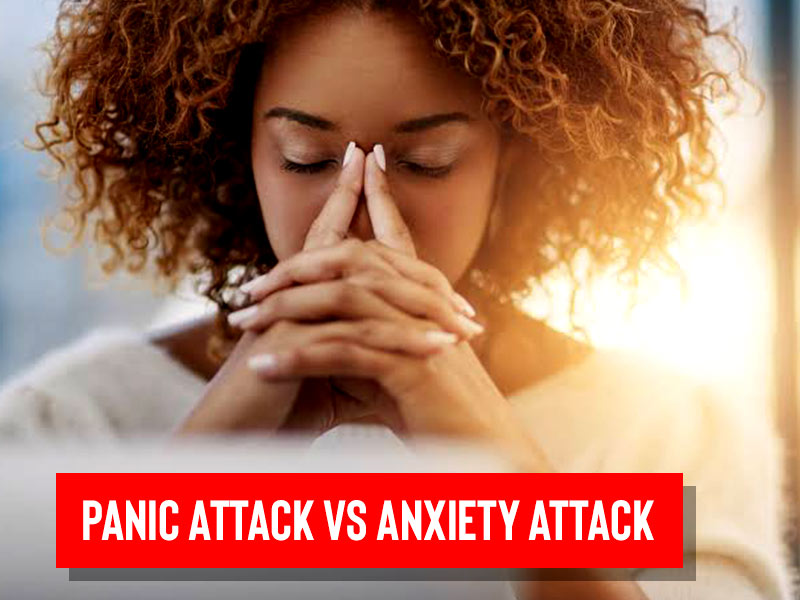
Panic attack and anxiety attack are two completely different terminologies, but tend to have some similar symptoms. These types of attack have different intensities and durations. You might hear people talking about panic attacks and anxiety attacks like they’re the same thing. They’re different conditions though.
Table of Content:-
The differences between panic and anxiety are best described in terms of the intensity of the symptoms and the length of time the main symptoms occur. Panic attacks usually peak at around 10 minutes while anxiety can last for months. Onlymyhealth editorial team spoke to Dr. Reema Gupta, Consultant, Clinical Psychology, Max Super Speciality Hospital, Shalimar Bagh, in a healthy day special week live session series, to know about the difference between panic attack and anxiety attack.
Panic attack

Panic attacks are generally more intense and sudden than anxiety attacks. They also come on out of the blue, while anxiety attacks are often associated with a trigger. Panic attacks can happen to anyone, but having more than one may be a sign of panic disorder.
Symptoms of panic tend to peak after 10 minutes, then gradually subside. However, several panic attacks can occur in a row, making it seem like an attack is lasting for much longer. After an attack, many people feel stressed, worried, or otherwise unusual for the rest of the day.
Also read: 8 Ways To Stop Panic Attack Right Away
Symptoms
Panic attacks come on suddenly, without an obvious trigger. According to Dr. Rima, here are the main symptoms of a panick attack:
- Rapid heartbeat
- Nausea
- Chest pain
- Shaking
- Shortness of breath
- Sweating
- Dizziness
- Numbness
- Feel like they are going crazy
Causes of panic attack
Panic attacks can be expected or unexpected. Unexpected attacks have no apparent triggers. Panic attacks usually occur out of the blue without an obvious, immediate trigger. In some cases, however, they are "expected" because the fear is caused by a known stressor, such as a phobia.
Anxiety attack

Anxiety, on the other hand, is part of the emotional and protective responses hardwired into the human body. It is when anxiety is excessive or gets in the way of your everyday life that there is cause for concern.
While panic attacks come on suddenly, symptoms of anxiety follow a period of excessive worry. Symptoms may become more pronounced over a few minutes or hours. They are typically less intense than those of panic attacks. Anxiety symptoms often last longer than the symptoms of a panic attack. They may persist for days, weeks, or months.
Also read: What Is Anxiety? Know 7 Ways Through Which Anxiety Can Affect Your Health
Symptoms
Anxiety is usually related to the anticipation of a stressful situation, experience, or event. It may come on gradually. The lack of diagnostic recognition of anxiety attacks means that the signs and symptoms are open to interpretation. The main symptoms of anxiety are:
- Stress
- Rapid heart rate
- Fear
- Trembling
- Worry
- Disturbed sleep
- Lack of concentration
- Muscle stress
Tips to cope up from panic and anxiety attack
Here are some useful tips to cope up from panic and anxiety attack:
- Panic attacks usually occur without a trigger. Anxiety is a response to a perceived stressor or threat.
- Symptoms of a panic attack are intense and disruptive. They often involve a sense of “unreality” and detachment. Anxiety symptoms vary in intensity, from mild to severe.
- Panic attacks appear suddenly, while anxiety symptoms become gradually more intense over minutes, hours, or days.
- Panic attacks usually subside after a few minutes, while anxiety symptoms can prevail for long periods.
Effective treatments are available that can improve outcomes and well-being, so it is important to talk to a doctor if you are having symptoms of anxiety or panic attacks. During an evaluation, the doctor will take a medical history, a physical exam, and may run lab tests to help rule out any medical illnesses that might be contributing to your symptoms.
Professionals who treat mental health conditions base a diagnosis on criteria found in the Diagnostic and Statistical Manual of Mental Disorders (5th edition), known as the DSM-5. Though anxiety and panic attacks may feel similar, the differences outlined in the DSM.
Also watch this video
How we keep this article up to date:
We work with experts and keep a close eye on the latest in health and wellness. Whenever there is a new research or helpful information, we update our articles with accurate and useful advice.
Current Version